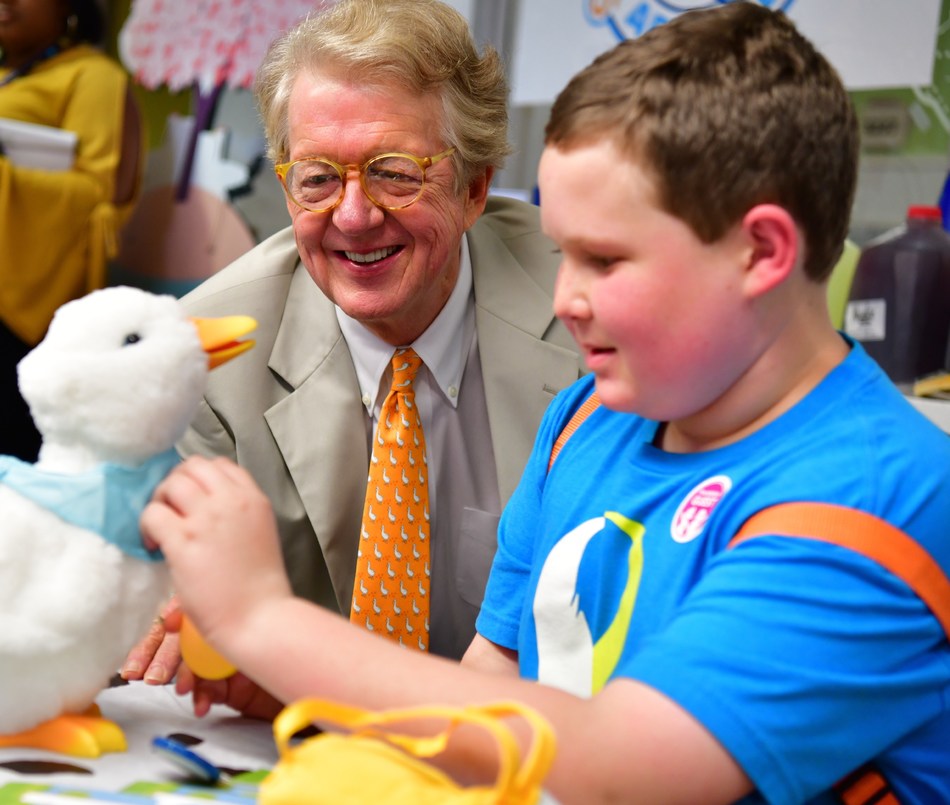Say "Quack"

"He couldn't even say, 'Why am I taking this medication'?"
"At the same time, we didn't have the words to give him answers or explain to him what was making him sick."
"He's able to say [now[, 'My bones hurt more than usual', for example, which we didn't know before. I'll say, 'How are you feeling outside'? and he'll pick the emoji that is silly. And then I'll say, 'How are you feeling inside'? and when he's feeling horrible he'll pick up the emoji that shows he's feeling really bad."
"It's hard to imagine what a two-year-old is deriving from this whole journey [of chemotherapy]. So it's good for him to be able to emote what he's feeling also."
Rachid Abdallah, Children's National Health System, Washington
"If there's a ten-year-old, I can focus on the technology and the cool things the duck can do. But if I'm giving it to a four-year-old, it's more like, 'This is your friend. This is your buddy who is here with you."
"It's always therapeutic. It can be therapeutic to educate a child or it can just be therapeutic for them to play with a duck and not even talk about the medical aspect of things."
"There are so many ways we can use it [child-centric therapeutic duck robot]."
Joe Bauer, certified child life specialist, Children's National Health System
:no_upscale()/cdn.vox-cdn.com/uploads/chorus_asset/file/10011771/aflac_duck_rfid.jpg)
Over fifteen thousand children and teenagers are diagnosed annually with cancer in the United States, according to figures from the American Childhood Cancer Organization. Aflac, the larges private insurer in the U.S., used a quacking duck as a mascot in its commercials several decades ago. Now, in a partnership between Aflac and robotics toy company Sproutel, a robot named My Special Aflac Duck has been produced for child-friendly therapeutic purposes.
This endearing little robotic creature has special features that help children deal with their physical pain and emotional puzzlement over how they feel, being treated for cancer. The insurance company has donated four thousand of the robotic duck models to about two hundred hospitals across the United States. Designed as a companion for children whose lives have been compromised by serious illness it guides children to be able to express their emotions when language itself fails them.
"It is an indescribable feeling to see the smile on children's faces when they receive My Special Aflac Duck.
"It is wonderful to know that they enjoy the functions of the duck that we designed specifically for them. We're honored to work with Aflac and see this grow from a concept to a program that is impacting the lives of children across the country."
Sproutel CEO and Co-Founder Aaron Horowitz
 |
| Aflac Chairman and CEO Dan Amos with a 13 year old patient at the Aflac Cancer and Blood Disorders Center in Atlanta, GA admiring the My Special Aflac Duck at a "duck delivery" event in September |
There are plastic emoji discs that the robot comes with, each of them characterizing an emotion. Placing any of the discs against the duck's chest programs the robot to act out the specific emotion that the disc represents. The duck emits sounds representing happy chirps all the way to uneasy moans. The My Special Aflac Duck makes use of a series of touch sensors enabling the device to respond to whoever interacts with it.
The robot is able to turn its neck, nuzzle, open its beak -- and it emits sounds and vibrations. The duck can emit a series of pulses designed to mimic a heartbeat that can assist in calming a child and guide their breathing, useful when doctors want a patient to breathe in a rhythmic pattern. When medications are administered to patients, a toy syringe can be attached to the robot allowing a child to mimic what is happening to themselves by giving the duck medication as well.
Coping strategies are developed to help guide a child toward a feeling of control in uncertain environments, or to distract them through times of extreme stress, according to the experts. It helps them to deal with the painful pricks caused by syringes. And this sense of calm and control distracting the child from the immediate discomfort felt -- and insecurity, is provided with the use of the duck.
Rachid Abdallah, whose two-year-old son Savi Abdallah-Sinha underwent initial chemotherapy treatment to expunge leukemia from this body, considers the robot duck to be a "great translator". The child was unable to communicate at that age the acute pain he was experiencing each time a new drug was introduced or a treatment completed, during the first months chemotherapy began. And then, a year ago the family received a new tool meant to help in communicating; the quacking robotic duck that seemed like a soft stuffed animal.
Now, Savi is four years old and is able to express how he feels, giving his parents details once unavailable when he was younger. In his final phase, and the least intensive of his three-year chemotherapy plan, the child -- often stoic in the face of pain -- hesitates to communicate distress. Which makes the duck as a communication tool, particularly useful.
 |
| A robotic duck helps Savi Abdallah-Sinha, 4, and battling leukemia, share his ups and downs. The Washington Post |
Labels: Childhood Cancer, Health, Medicine, Therapy

0 Comments:
Post a Comment
<< Home